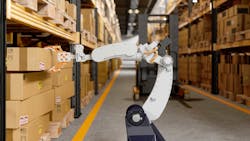New Charging Technologies in Warehouse Automation
Automation is radically transforming warehouse operations. According to a survey by Robotics Business Review, automated warehouses are 76% more likely to boost inventory accuracy by 99% or higher and are 40% more likely to ship within one day of an order’s placement.
As manufacturers begin to explore transitioning manual warehouses to automated ones, they must first understand where they are and where they want to go. There are various levels of automation, ranging from several semi-automated applications to fully automated systems.
The majority of warehouses today operate with a hybrid model to ease employee workload. In addition, hybrid automation systems improve and optimize warehouse operations to help meet increasing demand faster.
Applied Automation
As manufacturers begin to add autonomous technology into the warehouse, one of the first processes to become supported by automation is the picking process. The picking process for line items is time-intensive and labor-consuming. Pick-by-voice and pick-by-light speed up the picking process by removing the need for hands-on selection. This allows warehouses to grow faster and scale easily without needing additional human labor.
Because of enhanced speed and capacity of operation, autonomous solutions are becoming more prominent in warehouses. This is especially important in the cold grocery storage space, where people prefer to let machines work in colder temperatures and conditions. Automated guided vehicles (AGVs) can bring a shelf from cold storage to a human, improving the overall work environment for employees. AGVs and mobile robots use advanced navigation systems and artificial intelligence to improve productivity.
Enabling Opportunistic Charging
Electrification of equipment such as forklifts has been widely adopted in the warehouse space. The benefits of electrification are numerous, from reduced noise pollution and carbon emissions to energy and cost savings. However, electrification does not come without unique challenges.
A primary remaining issue of electric technology is charging downtime. Traditional lead-acid battery technology requires long amounts of time, extra warehouse space and sometimes battery swaps, reducing overall productivity. However, recent lithium-ion battery technology reduces downtown by charging batteries without needing to completely replace them—the batteries survive many charging cycles.
Rather than waiting hours for a battery to charge, lithium-ion technology gives a constant supply of currents and the right amount of voltage for fast charging capabilities. With opportunistic charging, the battery charges whenever possible, including very short breaks when workers grab coffee. This leads to smaller battery sizes, less weight as cost at the end and improved overall profitability of machines.
However, new battery technologies and frequent charging pose unique challenges leading to significant changes in the design and specification of the electric powertrain. These effects include the need for sophisticated battery management systems, demand for increased charging power and a higher number of charging cycles for the charging infrastructure (for example, charging connector mating). At the same time, operators want to limit the manual labor involved in charging operations, which leads to the requirement for AGVs and autonomous mobile robots (AMRs) to be charged autonomously at docking stations.
Reliable and compact battery and charging solutions, as well as higher efficiency drive technology, are primary focuses for electric technology in the warehouse. In order to further improve overall production and efficiency of warehouse operations, these central focuses must be addressed.
Meeting Expectations
As the world continues to grapple with the ongoing effects of COVID-19, one trend has become clear: Consumers prefer to shop online. Ecommerce and online grocery shopping have skyrocketed, nearly doubling between 2019 and 2020. This trend is not likely to go away.
Furthermore, as consumers have become accustomed to ordering groceries and necessities from their homes, the expectation to receive these products within only a few days has become the norm. The demand for goods to be delivered quickly has never been so high.
Warehouse manufacturing and logistics is a labor-intensive field—from physically picking line items to managing grocery items that require cold storage. However, warehouses responsible for producing and delivering on these consumer expectations face severe labor shortages and high employee turnover rates.
Between increasing pressure to deliver goods faster and a decreasing labor pool from which to meet these demands, one solution becomes clear: Warehousing must move toward more advanced automation in order to ease employee workloads. And it must do so quickly.
Daniel Walldorf is a strategy and business development manager at TE Connectivity.
About the Author
Daniel Walldorf
Strategy and Business Development Manager, TE Connectivity.
Daniel Walldorf is a strategy and business development manager at TE Connectivity.


